




Your support is critical to our success.
Accepted Scientific Name: Jatropha curcas L.
Sp. Pl. 1006 (1753) L.
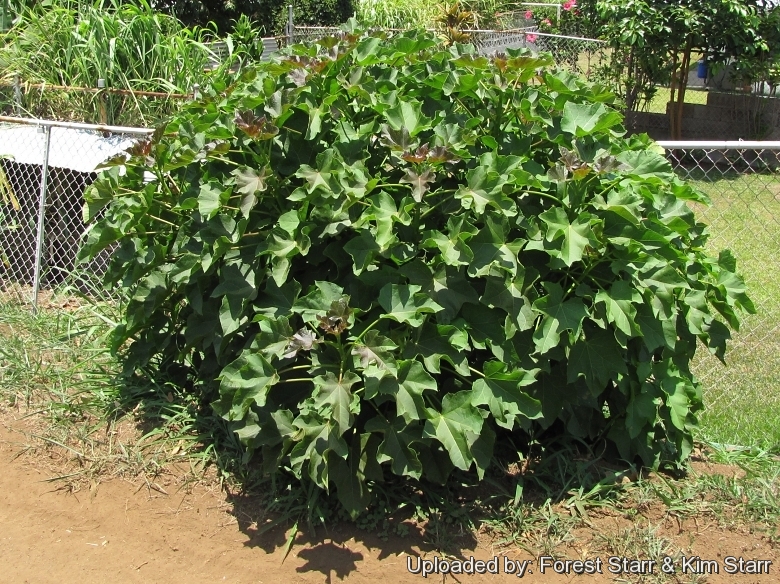
Habit behind houses at Pahala, Hawaii (USA). July 17, 2012.
Origin and Habitat: Jatropha curcasSN|28980]]SN|28980]] is most likely from the Mexican-Central American region, but widely distributed and naturalized in South and Central America, Africa and Asia and grows under wide range of arid and semi-arid climatic conditions.
Altitude range: It is found from sea level to 1500 m altitude.
Habitat and ecology: This succulent species can be found from dry tropical to moist subtropical to wet tropical forest. Leaves are shed during the dry season. It can tolerate variable rainfall (200-2380 mm/year), being able to survive with 200 mm, and 800 mm being enough for production. A temperature of 20-28°C is the best and it can tolerate light frosts. It can be cultivated successfully in regions with scanty to moderate rainfall and can be used to control soil erosion. It is also widely cultivated as an ornamental tree throughout the tropics.
Synonyms:
- Jatropha curcas L.
- Curcas curcas (L.) Britton & Millsp.
- Manihot curcas (L.) Crantz
Jatropha curcas L.
Sp. Pl. 1006 (1753)
Synonymy: 17
- Jatropha curcas L.
- Curcas curcas (L.) Britton & Millsp.
- Manihot curcas (L.) Crantz
- Castiglionia lobata Ruiz & Pav.
- Curcas adansonii Endl.
- Curcas drastica Mart.
- Curcas indica A.Rich.
- Curcas lobata Splitg. ex Lanj.
- Curcas purgans Medik.
- Jatropha acerifolia Salisb.
- Jatropha afrocurcas Pax
- Jatropha condor Benth.
- Jatropha edulis Sessé
- Jatropha yucatanensis Briq.
- Ricinoides americana Garsault
- Ricinus americanus Mill.
- Ricinus jarak Thunb.
ENGLISH: Barbados nut, Chinese castor oil, JCL (abbreviation of Jatropha curcas Linnaeus), Purging nut, Castor oil, Fig nut, Curcas, Teermite plant, Physic nut, Pig nut, Wild oil nut
AFRIKAANS (Afrikaans): Purgeerboontjie
ANAANG or WESTERN IBIBIO (Anaang): Mbubok
ARABIC ( لعربية ): جتروفا كوركاس, Babel meluk, Dand barri
BAMBARA (Bamanankan): Bàgànin, Bagani
BENGALI (বাংলা): kochagach, দন্তিগাছ dantigaacha, সাদা ভেরেন্ডা, দন্তী danti
BWARI (Kabwari): Kwotewi
CATALAN (Català): pinyó de l'Índia
CHICHEWA (Chicheŵa): Nsadsi
CHINESE (中文): Yu-lu-tzu, 桐油樹, 麻风树、痲瘋樹、南洋油桐、黄肿树、假白榄等
CZECH (Čeština): Dávivec černý
DUTCH (Nederlands): Purgeernoot, Schijtnoot
EDO or BINI (Ẹ̀dó): Oru-ebo
EFIK or RIVERAIN IBIBIO (Efik): Eto-mkpa
FINNISH (Suomi): Jatrofa, Jatropa
FRENCH (Français): Medicinier (Haiti), Pourghère (Francophone Africa)
FULA or FULANI (Fulfulde, Pulaar, Pularl): Kwolkwelaje
GARHWALI (गढ़वळि भाख/भाषा): Lanka bel
GERMAN (Deutsch): Purgiernuss
GUJARATI (ગુજરાતી): RatanJyot
HAITIAN CREOLE (Kreyòl ayisyen): Gwo Medsiyen, Medsiyen, Metsiyen
HAUSA (Harshen Hausa هَرْشَن هَوْسَ ): Chi ni da zugu, Bi ni da zugu
HINDI ( हिन्दी): दन्ती danti
IGBO (Asụsụ Igbo): Clu, Uru-ekpa, Owulu-idu, Olulu-idu
INDONESIAN (Bahasa Indonesia): Jarak pagar
JAPANESE (日本語): ナンヨウアブラギリ
JAVANESE (Basa Jawa): Jarak Pagar
KANNADA (ಕನ್ನಡ): ದಮ್ತಿ damti, ಕಾಡು ಹರಳು kaadu haralu, ನಾಗದಮ್ತಿ naagadamti
KAPAMPAGAN (Kapampangan): Galumbang
KONKANI (कोंकणी koṃkaṇī): Baktumbo
MALAYALAM (മലയാളം): ചെറിയദന്തി ceriyadanthi, നാഗദന്തി naagadanthi, കടലാവണക്ക് Kadalavanakku
MANIPURI or MEETEI MAYEK (মৈতৈলোন্): Awa ke-ge
MARATHI (मराठी): कातरी katari, दंती danti
NDEBELE (NORTHERN) (Sindebele / isiNdebele): uMhlafutho
NEPALESE (Nepal bhasa नेपाल भाषा): दुधे झार dudhe jhaar, अजय पाल ajaya pal, सजीवन
ORIYA (ଓଡି଼ଆ): ଏକ ପ୍ରକାରର ଔଷଧ
PERSIAN (فارسی): Bedanjire khatai
POLISH ( Polski): Jatrofa przeczyszczająca
PORTUGUESE (Português): Pinhão manso, Mundubi-assu, Purgueira, Pinha-de-purga, Pinhão-manso, Mandubiguaçu, Pinhão-de-purga
RUSSIAN (Русский): Ятрофа куркас
SANSKRIT (संस्कृतम्): नागविन्ना nagavinna, उडुम्बरपर्णी udumbaraparni, एरण्डपत्रिका erandhapatrika, मकूलकः makulakah, नागदन्ती nagadanti, निकुम्भः nikumbha, एरण्डफला erandhaphala, दीर्घ dirgha, दन्तिका dantika, अनुकूला anukula, रेचनी rechani, प्रत्यक्श्रेणी pratyanshrani, विशल्य vishalya, दन्ती danti, शीघ्रा shigra, रूक्षा ruksha
SPANISH (Español): Tempate, Nuez de Barbados, Cotoncillo, Coquillo, Piñón de cerca, Piñón botija, Piñoncillo, Sangregado, Frailejón, Piñón purgante, Piñón lechero, Tártago, Jatrofa, Frailecillo, Piñón de tempate, Tua tua, Pinol
SWAHILI ( Kiswahili): Mbono kaburi, Mbono
TAMIL (தமிழ்): பேயாமணக்கு pey-amanakku, காட்டாமணக்கு kaattaamanakku
TELUGU (తెలుగు): కొండ ఆముదము kond amudamu, నేపాళము nepalamu, అడవి ఆముదము చెట్టు, అడవి ఆముదము adavi amudamu, నేల జీడి nela jidi
THAI (ภาษาไทย): Saboo Dam (สบู่ดำ)
TONGAN (Faka-Tonga): Fiki
UKRAINIAN (Українська): Ятрофа куркас
VIETNAMESE (Tiếng Việt): dầu lai, cây cọc rào, Dầu mè, cọc giậu
WOLOF (Wolof): Tabanani
YORUBA (èdè Yorùbá): Bòtújẹ̀, Lóbòtújè, Làpálàpá, Seluju, Lapalapa, Polopolo, Botuje
Description: Jatropha curcasSN|28980]]SN|28980]] is a perennial succulent shrub or small tree growing 2-6 m tall with spreading branches and viscid milky sap, which sometimes is reddish and gummy.
Stems: Somewhat succulent becoming woody at the base. The greenish-yellow bark exudes milky or yellowish latex.
Leaves: Evergreen or deciduous (under drought conditions), alternate to subopposite with a spiral phyllotaxis and crowded near the apex of the small branches, variable in their morphology, 3-5 lobed or sometimes entire and (6-)10-15(-40) cm long and broad, green to pale green, on 2.5-7.5 cm long petioles, openly cordate at the base; stipules small; margins undulating; stomata hypostomatic (mostly on the underneath surface). Leaves secrete a white, milky latex when cut.
Inflorescence: Axillary paniculate glabrous or pubescent cymes at the end of the branches.
Flowers: Yellowish green unisexual, monoecious, but occasionally hermaphroditic. Each inflorescence normally produces one to five female flowers surrounded by 25-93 male flowers, the male and female flowers are borne at different times. The petiole length ranges from 6 to 23 mm. The yellowish, male flowers are bell-shaped. The male flowers have up to ten stamens in two distinct whorls, five of which are united at the base and five united into a column. The female flowers are borne singly and have a three-celled, tri-ovulate ovary with three spreading bifurcate stigmas. Petals 6-7 mm long. Cross pollination occurs by entomophily. Pollination is potentially influenced by both pollen depositions on stigma and nectar availability. Female flowers produce more nectar than male flowers. The species is insect pollinated. Occasionally, hermaphroditic flowers are self-fertile.
Phenology: Jatropha curcasSN|28980]]SN|28980]] flowers twice a year. Two flowering peaks occur in the topics when there is one wet and one dry season. When there is no marked dry season, flowering occurs throughout the year. The flowers open from 5:30 to 6:30 a.m. and the anthers dehisce about 1 h later. The flowers last about 11 days and about 50% fruit set occurs. Seeds usually mature within 1 to 3 month. Fruits are produced for the most part in midsummer to late fall and in winter, or there may be several crops during the year if soil moisture is good and temperatures are sufficiently high with variations in production peaks where some plants have two or three harvests and some produce continuously through the season.
Fruits (trilocular capsules): Long, yellow, subspherical or ellipsoidal, (1.5-)2,5-3.0(-4) cm long, that turn yellowish brown at maturity and black upon drying, when they split into three valves and each one has an oblong, black seed (1.5-2 cm by 1-1.1 cm), with two cotyledons containing 60-68% oil.
Seedlings: Normally, five roots are formed from seedlings: one central and four peripheral.
Bibliography: Major references and further lectures
1) Forest & Kim Starr “Jatropha curcas (physic nut, Barbados nut)”. Plants of Hawaii. <http://www.starrenvironmental.com>. Web. 27 Sep. 2014.
2) Wikipedia contributors. "Jatropha curcas ." Wikipedia, The Free Encyclopedia. Wikipedia, The Free Encyclopedia, 14 May. 2014. Web. 27 Sep. 2014.
3) Nasir El Bassam “Handbook of Bioenergy Crops: A Complete Reference to Species, Development and Applications” Earthscan, 2010
4) Joachim Heller “Physic Nut, Jatropha Curcas L.” Bioversity International, 1996
5) Norman Jones, Joan H. Miller, World Bank. Asia Technical Dept. Agriculture Division “Jatropha curcas: a multipurpose species for problematic sites” World Bank, Asia Technical Dept., Agriculture Division
6) Maurice M. Iwu “Handbook of African Medicinal Plants” Second Edition CRC Press, 18/Feb/1993
7) Nahar, K. and Ozores-Hampton, M. “Jatropha: An Alternative Substitute to Fossil Fuel.” (IFAS Publication Number HS1193). Gainesville: University of Florida, Institute of Food and Agricultural Sciences. 2011
8) Janick, Jules; Robert E. Paull “The Encyclopedia of Fruit & Nuts.” CABI. 2008
9) Umberto Quattrocchi “CRC World Dictionary of Medicinal and Poisonous Plants: Common Names, Scientific Names, Eponyms, Synonyms, and Etymology” (5 Volume Set) Copertina anteriore CRC Press, 03/May/2012
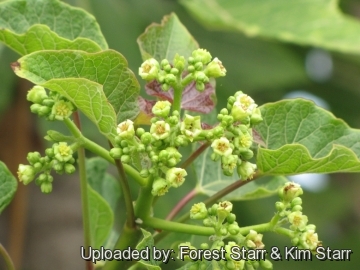
Flowers and leaves at Lahaina, Maui, Hawaii (USA). July 13, 2009. (Jatropha curcas) Photo by: Forest Starr & Kim Starr
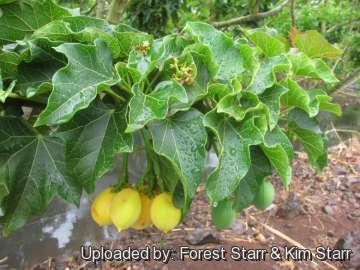
Flowers fruit and leaves at Kula Agriculture Park, Maui, Hawaii (USA). June 20, 2012. (Jatropha curcas) Photo by: Forest Starr & Kim Starr
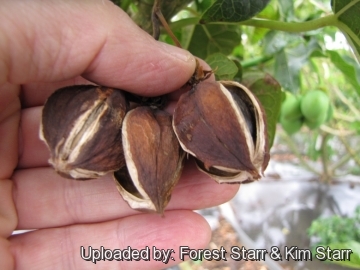
Fruit with seeds at Kula Agriculture Park, Maui, Hawaii (USA). June 20, 2012. (Jatropha curcas) Photo by: Forest Starr & Kim Starr
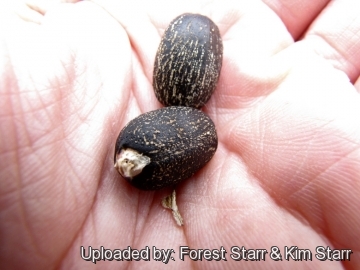
Seeds at Kula Agriculture Park, Maui, Hawaii (USA). June 20, 2012. (Jatropha curcas) Photo by: Forest Starr & Kim Starr
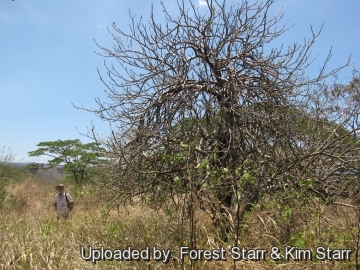
Habit with Bob at Kau, Hawaii, Hawaii (USA). July 17, 2012. (Jatropha curcas) Photo by: Forest Starr & Kim Starr
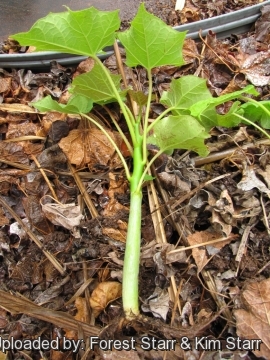
Seedling at Kula Agriculture Park, Maui, Hawaii (USA). June 20, 2012. (Jatropha curcas) Photo by: Forest Starr & Kim Starr

Plantation at Hilo, Hawaii, Hawaii (USA). July 17, 2012. (Jatropha curcas) Photo by: Forest Starr & Kim Starr

Leaves at Kahikinui, Maui, Hawaii (USA). March 20, 2007. (Jatropha curcas) Photo by: Forest Starr & Kim Starr
Cultivation and Propagation: Jatropha curcasSN|28980]]SN|28980]] is an adaptable species that does best in drier tropical areas and is undemanding on soil, being well adapted to poorer soils and full sun to light shade. This plant develops in a fashion similar to a sprawling shrub or small tree and is tolerant of heat and drought and cultivation is uncomplicated.
Growth rate: They can grow fast. The juvenile period for seedlings is about 4-5 months and full productivity is reached in about 3 years while cuttings can start producing after 1 year. The tree has a productive life of 40-50 years.
Soil: The plant grows best on well-drained soils with good aeration. Root growth is reduced on heavy soils. The plant can grow in wastelands and grows on almost any terrain, even on gravelly, sandy and saline soils. It can thrive in poor and stony soils. For pot culture a gritty, very free-draining compost is suitable, and clay pots help the plants to dry out between watering. Re-pot every 2-3 years.
Fertilization: Jatropha curcas respond well to fertilizer (once every one to two months).
Watering: They like only a short winter's rest and should be kept almost completely dry during the winter months. If the soil is allowed to be dry for too long root loss could follow but equally the same result would occur if the plants are both wet and cold. From March onwards the plant will begin to grow and watering should be increased gradually until late May when the plant should be in full growth. Water regularly during the summer so long as the plant pot is allowed to drain and not sit in a tray of water. During hot weather you may need to water the plants more frequently so long as the plant is actively growing. From late September watering should be reduced to force the plant to go in to a state of semi dormancy, by October you should be back in to the winter watering regime.
Hardiness: Tender, protect from frost. Temperature spring to autumn: nocturnal at least 18°C and diurnal up to 38°C. Wintering: nocturnal 12°C and diurnal 20°C or more.
Pruning: Generally not necessary to prune plants except to remove dead branches and leaves for a cleaner appearance in the landscape. However this species do tend to get sort of leggy and pruning is sometime necessary to keep hedged and pruned to maintain the shape. Repeatedly prunings also help to encourage new growth. The flowers only develop terminally (at the end of a stem), so a good ramification (plants presenting many branches) produces the greatest amount of fruits. A viscid milky, sticky latex naturally oozes from wounds.
Pest and diseases: The use of pesticides is rarely necessary, due to the pesticidal and fungicidal properties of the plant. However wet may cause root and stem rot, especially during winter months. Powdery mildew may damages leaves and flowers; Alternaria causes premature leaf fall, Clitocybe tabescens causes root rot, Colletotrichum gloeosporioides leaf spot and Phakopsora jatrophicola that causes rust. Pests of Jatropha curcasSN|28980]]SN|28980]] include whitefly, scale insects, and mealybugs. Often the scale in-sects and mealybugs are brought in and protected by ants. Spider mites can also can damage to leaves. In Zimbabwe, a golden flea beetle eats the young leaves and shoots.
Propagation: Jatropha curcasSN|28980]]SN|28980]] has limited natural vegetative propagation and is usually propagated by seed. Take extra care to avoid letting the seedbed dry out. Complete germination is achieved within 9 days (sometimes take longer). Let the seedlings grow to about 10-15 cm in height before separating and transplanting to individual containers. Adding manure during the germination has negative effects during that phase, but is favourable if applied after germination is achieved. You can also propagate Jatropha curcasSN|28980]]SN|28980]] by stem tip cuttings, which yields faster results than multiplication by seeds. The cuttings readily root. The cuttings should be taken preferably from actively growing tips with mostly green wood and treated with rooting hormone to ensure the highest level of rooting. After root growth and new stem growth are obvious, transfer the new plant to a standard potting mix.
Warning: All the parts of the plant are considered as poisonous. When a plant get damaged it exudes a thick white milky sap known as latex. This latex is poisonous and particularly dangerous for the eyes, skin and mucous membranes. So pay extreme attention not to get any in your eyes or mouth. Cultivated plants must be handled carefully. If consumed severe nausea, vomiting, diarrhea, gastroenteritis, blindness are expected.
Biofuel: Currently the oil from Jatropha curcasSN|28980]]SN|28980]] seeds is used for making biodiesel fuel in Philippines, Pakistan and in Brazil, where it grows naturally and in plantations in the southeast, north, and northeast of Brazil
Other uses: The species is listed as a honey plant. The nuts are sometimes roasted and eaten, although they are purgative. The oil has been used for illumination, soap, candles, the adulteration of olive oil, and making Turkey red oil, also called sulphonated (or sulfated) castor oil, is the only oil that completely disperses in water. It is made by adding sulfuric acid to pure Jatropha oil. It was the first synthetic detergent after ordinary soap, as this allows easy use for making bath oil products. It is used in formulating lubricants, softeners, and dyeing assistants. The ashes obtained from roots are used as a salt substitute. Jatropha curcasSN|28980]]SN|28980]] is also used in the preparation of arrow poison and in the Philippines the bark is used to prepare a fish poison. The seeds are often a source of accidental poisoning, both in animals and humans. The young leaves may be eaten, steamed or stewed. Cooked with goat meat, they are said to advantageously counteract its smell [We do not suggest plants for consumption!] .
| Your Actions | |
|---|---|
| Back to Manihot index | |
| Back to Euphorbiaceae index | |
 |
Back to Succulents Encyclopedia index |
Privacy stantement - Terms and conditions - How to cite - About us - Feedback - Donate



